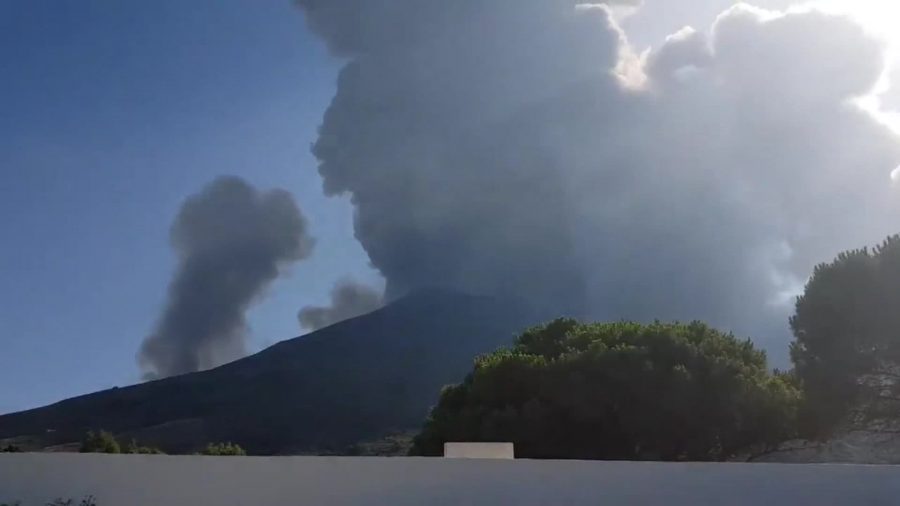A series of eruptions from one of the most active volcanoes on Earth rocked the small Italian island of Stromboli on July 3, according to Italy’s Department of Civil Protection.
Two primary explosive events occurred around 4:46 p.m., local time, on the island, which is located in Tyrrhenian Sea, off the north coast of Sicily, the National Institute of Geophysics and Volcanology reported. Those events were preceded by lava spills about two minutes prior.
“The analysis of the data of the seismic network made it possible to identify, in addition to the major explosions, about 20 minor explosive events,” according to the institute.
The initial explosion was the largest at least since 2007, Boris Benhcke, a volcanologist with the institute posted on Twitter.
#stromboli The explosion as the Skyline camera saw it. pic.twitter.com/Yw9oXPfkKX
— Alex Bogár (@AlexEtna) July 3, 2019
Firefighters were deployed to extinguish fires started by the eruption, and a helicopter was dispatched to rescue hikers who signaled distress, according to fire brigade Vigili del Fuoco. Two hikers were injured, the fire brigade confirmed to CNN.
Tourists took shelter in the sea, Italian news agency ANSA reported.
Social media pictures show Stromboli engulfed in a huge plume of smoke, visible from other islands kilometers away.
Stromboli just erupted. Big time. pic.twitter.com/vajLpp2itV
— Fiona Carter (@FionaCarter) July 3, 2019
Stromboli is one of the eight Aeolian Islands, a volcanic arc north of Sicily and a popular tourist destination. Stromboli has been in a near-continuous eruptive phase for decades.
The volcano is known as “the lighthouse of the Mediterranean” because of its frequent, bright eruptions at night. Wednesday’s eruptions are considerably more than normal.
View from the Panarea harbor as Stromboli erupts. Hoping everyone is safe on the ground. Visible lava flows headed down the mountain. pic.twitter.com/apZT3G3C57
— Alex Hopson (@TheAlexHopson) July 3, 2019
#Update: Video uploaded by one hiker who was running down the hill when he felt it, has caught a close shot of the 3KM high ash cloud of when it erupted on the island of #Stromboli in #Italy. pic.twitter.com/i96xotHly9
— Sotiri Dimpinoudis (@sotiridi) July 3, 2019
#Update: A video uploaded by one of the tourist on the island shows how close the Volcano top is on the small island of #Stromboli in #Italy pic.twitter.com/0sOP2iktju
— Sotiri Dimpinoudis (@sotiridi) July 3, 2019
Extinct Volcano Has Woken Up and Scientists Say It Could Erupt ‘At Any Moment’
A volcano in the far eastern corner of Russia that was previously considered extinct may be waking up, and an eruption could be catastrophic.
The Bolshaya Udina volcano—part of the Kamchatka Peninsula’s Udina volcanic complex—was believed to be extinct until 2017, when increasing seismic activity was detected beneath it, scientists say.

Now, Ivan Koulakov, a geophysicist from Russia’s A.A. Trofimuk Institute of Petroleum Geology and Geophysics who led a study into the volcano, believes it should be reclassified as active.
“At any moment, an eruption can occur,” Koulakov told CNN.
Between 1999 and September 2017, about 100 weak seismic events were detected beneath the volcano, which stands at 9,590 feet above sea level. An “anomalous increase” in seismicity, however, began in October 2017. Between October 2017 and February 2019, about 2,400 seismic events were recorded.
February saw an earthquake of 4.3 magnitude occur under Udina—the strongest seismic event ever to occur in the area.
Researchers from Russia, Egypt and Saudi Arabia conducted a study of the volcano last year between May and July, which was published in the Journal of Volcanology and Geothermal Research.
Installing four temporary seismic monitoring stations around Bolshaya Udina, the researchers recorded and analyzed 559 seismic events. An “elliptical cluster” of seismic activity had formed around the volcano, they determined, with seismic events taking place more than three miles beneath the surface.
“These seismic properties may indicate the presence of magma intrusions with a high content of […] fluids, which may justify changing the current status of this volcano from ‘extinct’ to ‘active,'” the researchers wrote.
Moreover, they observed that the cluster of seismic events connected the volcano with the Tolud zone, to the south of the volcano, a region believed to store magma in the Earth’s lower crust. The Tolud zone was now feeding Bolshaya Udina with magma, they concluded, thanks to a new pathway that developed in 2018.
Bolshaya Udina shares structural characteristics with another formerly extinct volcano in the region, the Bezymianny, which erupted dramatically in 1956, Koulakov told CNN.
There is around a 50% chance that Bolshaya Udina will erupt, he said.
“Or it could just release the energy smoothly over a few months, or it may just disappear without any eruption,” he said.
If the volcano does erupt, it could pose a significant threat to the small villages nearby, he said, though he added: “There are not many people around.”
A sizable eruption could also affect the climate in “completely different parts of the world,” he said. Ash released by the eruption could spread beyond Russia, disrupting air travel.
Unfortunately, the volcano is difficult to monitor, thanks to its distance from permanent seismic stations, Koulakov said.
“We need to deploy more stations to understand if it’s dangerous or not,” he said. “It’s highly unpredictable.”
![]()


